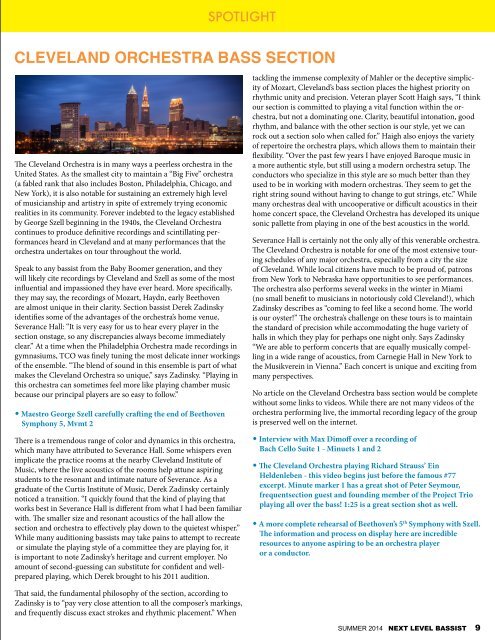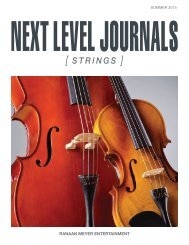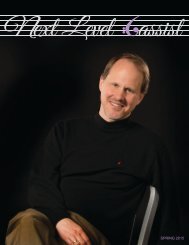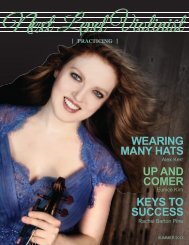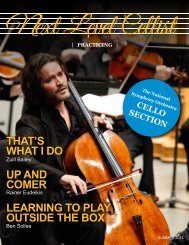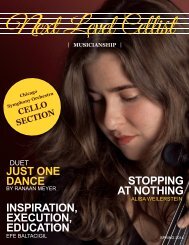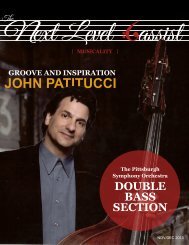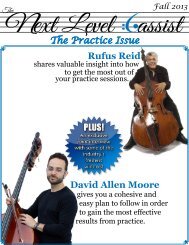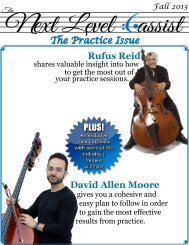Next Level Bassist Left Hand
Summer 2014 edition of Next Level Bassist. Left hand techniques and exercises by Nicholas Walker, Jordan Anderson, Paul Kowert. Section Spotlight on Cleveland Orchestra. Up and Comers Tim Dilenschneider and Jordan Morton
Summer 2014 edition of Next Level Bassist. Left hand techniques and exercises by Nicholas Walker, Jordan Anderson, Paul Kowert. Section Spotlight on Cleveland Orchestra. Up and Comers Tim Dilenschneider and Jordan Morton
Create successful ePaper yourself
Turn your PDF publications into a flip-book with our unique Google optimized e-Paper software.
Spotlight<br />
cleveland Orchestra Bass Section<br />
The Cleveland Orchestra is in many ways a peerless orchestra in the<br />
United States. As the smallest city to maintain a “Big Five” orchestra<br />
(a fabled rank that also includes Boston, Philadelphia, Chicago, and<br />
New York), it is also notable for sustaining an extremely high level<br />
of musicianship and artistry in spite of extremely trying economic<br />
realities in its community. Forever indebted to the legacy established<br />
by George Szell beginning in the 1940s, the Cleveland Orchestra<br />
continues to produce definitive recordings and scintillating performances<br />
heard in Cleveland and at many performances that the<br />
orchestra undertakes on tour throughout the world.<br />
Speak to any bassist from the Baby Boomer generation, and they<br />
will likely cite recordings by Cleveland and Szell as some of the most<br />
influential and impassioned they have ever heard. More specifically,<br />
they may say, the recordings of Mozart, Haydn, early Beethoven<br />
are almost unique in their clarity. Section bassist Derek Zadinsky<br />
identifies some of the advantages of the orchestra’s home venue,<br />
Severance Hall: “It is very easy for us to hear every player in the<br />
section onstage, so any discrepancies always become immediately<br />
clear.” At a time when the Philadelphia Orchestra made recordings in<br />
gymnasiums, TCO was finely tuning the most delicate inner workings<br />
of the ensemble. “The blend of sound in this ensemble is part of what<br />
makes the Cleveland Orchestra so unique,” says Zadinsky. “Playing in<br />
this orchestra can sometimes feel more like playing chamber music<br />
because our principal players are so easy to follow.”<br />
• Maestro George Szell carefully crafting the end of Beethoven<br />
Symphony 5, Mvmt 2<br />
There is a tremendous range of color and dynamics in this orchestra,<br />
which many have attributed to Severance Hall. Some whispers even<br />
implicate the practice rooms at the nearby Cleveland Institute of<br />
Music, where the live acoustics of the rooms help attune aspiring<br />
students to the resonant and intimate nature of Severance. As a<br />
graduate of the Curtis Institute of Music, Derek Zadinsky certainly<br />
noticed a transition. “I quickly found that the kind of playing that<br />
works best in Severance Hall is different from what I had been familiar<br />
with. The smaller size and resonant acoustics of the hall allow the<br />
section and orchestra to effectively play down to the quietest whisper.”<br />
While many auditioning bassists may take pains to attempt to recreate<br />
or simulate the playing style of a committee they are playing for, it<br />
is important to note Zadinsky’s heritage and current employer. No<br />
amount of second-guessing can substitute for confident and wellprepared<br />
playing, which Derek brought to his 2011 audition.<br />
That said, the fundamental philosophy of the section, according to<br />
Zadinsky is to “pay very close attention to all the composer’s markings,<br />
and frequently discuss exact strokes and rhythmic placement.” When<br />
tackling the immense complexity of Mahler or the deceptive simplicity<br />
of Mozart, Cleveland’s bass section places the highest priority on<br />
rhythmic unity and precision. Veteran player Scott Haigh says, “I think<br />
our section is committed to playing a vital function within the orchestra,<br />
but not a dominating one. Clarity, beautiful intonation, good<br />
rhythm, and balance with the other section is our style, yet we can<br />
rock out a section solo when called for.” Haigh also enjoys the variety<br />
of repertoire the orchestra plays, which allows them to maintain their<br />
flexibility. “Over the past few years I have enjoyed Baroque music in<br />
a more authentic style, but still using a modern orchestra setup. The<br />
conductors who specialize in this style are so much better than they<br />
used to be in working with modern orchestras. They seem to get the<br />
right string sound without having to change to gut strings, etc.” While<br />
many orchestras deal with uncooperative or difficult acoustics in their<br />
home concert space, the Cleveland Orchestra has developed its unique<br />
sonic pallette from playing in one of the best acoustics in the world.<br />
Severance Hall is certainly not the only ally of this venerable orchestra.<br />
The Cleveland Orchestra is notable for one of the most extensive touring<br />
schedules of any major orchestra, especially from a city the size<br />
of Cleveland. While local citizens have much to be proud of, patrons<br />
from New York to Nebraska have opportunities to see performances.<br />
The orchestra also performs several weeks in the winter in Miami<br />
(no small benefit to musicians in notoriously cold Cleveland!), which<br />
Zadinsky describes as “coming to feel like a second home. The world<br />
is our oyster!” The orchestra’s challenge on these tours is to maintain<br />
the standard of precision while accommodating the huge variety of<br />
halls in which they play for perhaps one night only. Says Zadinsky<br />
“We are able to perform concerts that are equally musically compelling<br />
in a wide range of acoustics, from Carnegie Hall in New York to<br />
the Musikverein in Vienna.” Each concert is unique and exciting from<br />
many perspectives.<br />
No article on the Cleveland Orchestra bass section would be complete<br />
without some links to videos. While there are not many videos of the<br />
orchestra performing live, the immortal recording legacy of the group<br />
is preserved well on the internet.<br />
• Interview with Max Dimoff over a recording of<br />
Bach Cello Suite 1 - Minuets 1 and 2<br />
• The Cleveland Orchestra playing Richard Strauss’ Ein<br />
Heldenleben - this video begins just before the famous #77<br />
excerpt. Minute marker 1 has a great shot of Peter Seymour,<br />
frequentsection guest and founding member of the Project Trio<br />
playing all over the bass! 1:25 is a great section shot as well.<br />
• A more complete rehearsal of Beethoven’s 5 th Symphony with Szell.<br />
The information and process on display here are incredible<br />
resources to anyone aspiring to be an orchestra player<br />
or a conductor.<br />
SUMMER 2014 NEXT LEVEL BASSIST<br />
9


